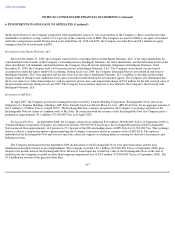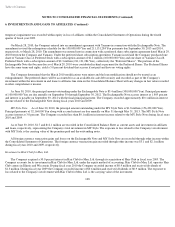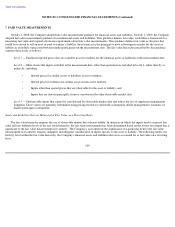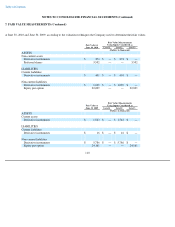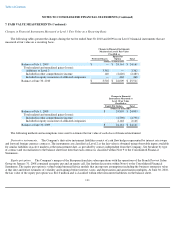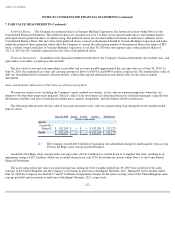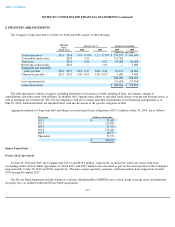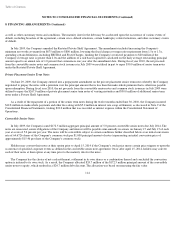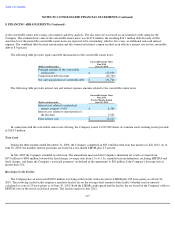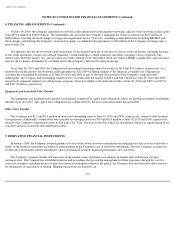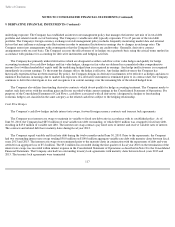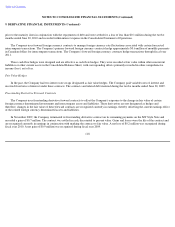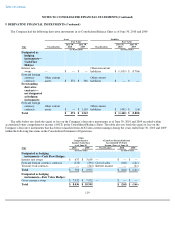Supercuts 2010 Annual Report Download - page 121
Download and view the complete annual report
Please find page 121 of the 2010 Supercuts annual report below. You can navigate through the pages in the report by either clicking on the pages listed below, or by using the keyword search tool below to find specific information within the annual report.
Table of Contents
NOTES TO CONSOLIDATED FINANCIAL STATEMENTS (Continued)
9. DERIVATIVE FINANCIAL INSTRUMENTS (Continued)
underlying exposure. The Company has established an interest rate management policy that manages the interest rate mix of its total debt
portfolio and related overall cost of borrowing. The Company's variable rate debt typically represents 35 to 45 percent of the total debt
portfolio. The Company's foreign currency exchange rate risk management policy includes frequently monitoring market data and external
factors that may influence exchange rate fluctuations in order to minimize fluctuation in earnings due to changes in exchange rates. The
Company enters into arrangements with counterparties that the Company believes are creditworthy. Generally, derivative contract
arrangements settle on a net basis. The Company assesses the effectiveness of its hedges on a quarterly basis using the critical terms method in
accordance with guidance for accounting for derivative instruments and hedging activities.
The Company has primarily utilized derivatives which are designated as either cash flow or fair value hedges and qualify for hedge
accounting treatment. For cash flow hedges and fair value hedges, changes in fair value are deferred in accumulated other comprehensive
income (loss) within shareholders' equity until the underlying hedged item is recognized in earnings. Any hedge ineffectiveness is recognized
immediately in current earnings. To the extent the changes offset, the hedge is effective. Any hedge ineffectiveness the Company has
historically experienced has not been material. By policy, the Company designs its derivative instruments to be effective as hedges and aims to
minimize fluctuations in earnings due to market risk exposures. If a derivative instrument is terminated prior to its contract date, the Company
continues to defer the related gain or loss and recognizes it in current earnings over the remaining life of the related hedged item.
The Company also utilizes freestanding derivative contracts which do not qualify for hedge accounting treatment. The Company marks to
market such derivatives with the resulting gains and losses recorded within current earnings in the Consolidated Statement of Operations. For
purposes of the Consolidated Statement of Cash Flows, cash flows associated with all derivatives (designated as hedges or freestanding
economic hedges) are classified in the same category as the related cash flows subject to the hedging relationship.
Cash Flow Hedges
The Company's cash flow hedges include interest rate swaps, forward foreign currency contracts and treasury lock agreements.
The Company uses interest rate swaps to maintain its variable to fixed rate debt ratio in accordance with its established policy. As of
June 30, 2010, the Company had $85.0 million of total variable rate debt outstanding, of which $40.0 million was swapped to fixed rate debt,
resulting in $45.0 million of variable rate debt. The interest rate swap contracts pay fixed rates of interest and receive variable rates of interest.
The contracts and related debt have maturity dates during fiscal year 2012.
The Company repaid variable and fixed rate debt during the twelve months ended June 30, 2010. Prior to the repayments, the Company
had two outstanding interest rate swaps totaling $50.0 million on $100.0 million aggregate variable rate debt with maturity dates between fiscal
years 2013 and 2015. The interest rate swaps were terminated prior to the maturity dates in conjunction with the repayments of debt and were
settled for an aggregate loss of $5.2 million. The $5.2 million loss recorded during the first quarter of fiscal year 2010 on the termination of the
interest rate swaps was recorded within interest expense in the Consolidated Statement of Operations as described in Note 8 to the Consolidated
Financial Statements. The Company also had two outstanding treasury lock agreements with maturity dates between fiscal years 2013 and
2015. The treasury lock agreements were terminated
117


